|
Speaker Response Curves
Those completely new to audio don't realize how important the speaker enclosure is when a desired frequency response is needed. Virtually all speakers will produce sound in virtually any enclosure but to get the best output from the speaker, it must be in the correct enclosure.
Sealed Enclosures
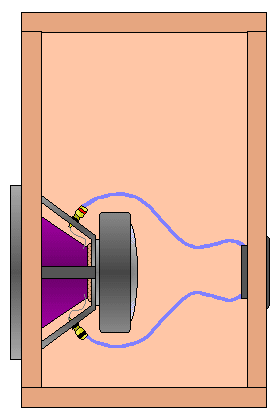
The sealed enclosure is the simplest of enclosures but there are still some things that you should know. If you have a speaker and all of the Theile/Small parameters and have decided what response that you want, you can enter them into the appropriate formulae to determine the proper enclosure volume. Actually I'd recommend downloading some of the software from the links page on this site instead of doing the 'formula' thing.
The following curves are the predicted response from a single woofer in 3 different enclosures. The upper left hand corner shows the 'alignment' of each curve. As you can see, the violet curve has the flattest response for the widest range of frequencies. The green curve gives a slight boost to some frequencies but rolls off earlier than the other curves. The red curve rolls off the slowest and gives the best low frequency extension. Each of these designs will work well in the appropriate situation. You must decide what you need and then design the proper enclosure. Notice the frequency response curve and the relative size of the enclosures.
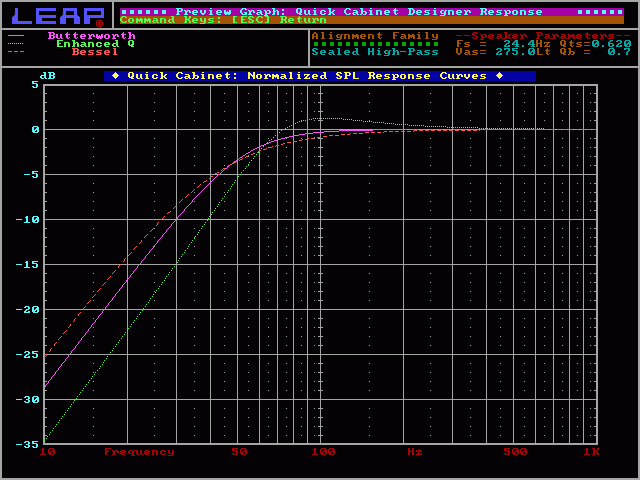
Violet curve
|
Green curve |
Red curve |
Enclosure volume =
2.68ft^3 |
Enclosure volume =
1.77ft^3 |
Enclosure volume =
4.68ft^3 |
Ported Enclosures

Ported enclosures are slightly more difficult to design than a sealed enclosure. When using a sealed enclosure, it is difficult to be so far off as to risk damaging the woofers. In any type of enclosure, the woofer relies (at least partly) on the enclosure for damping. If there is insufficient damping, the woofer's cone will move significantly more than it should. The ported box will provide virtually no damping below the port frequency (all of the control will be provided by the woofer's suspension). Below the tuning (port) frequency, it is possible to cause damage to the woofer well before power levels approach the maximum power ratings of the woofer. The respective alignments are again noted in the upper left hand corner. You can see that these response curves have a lower F3 (3dB down point) than the sealed enclosure but they use a larger enclosure and the low frequency response below the tuning frequency rolls off more quickly.
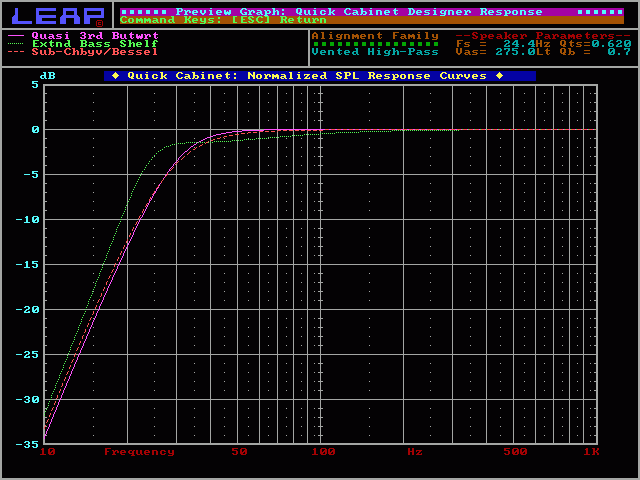
| Violet curve |
Green curve |
Red curve |
Enclosure volume =
4.16ft^3 |
Enclosure volume =
6.52ft^3 |
Enclosure volume =
4.111ft^3 |
Port tuning frequency =
27.8hz |
Port tuning frequency =
24.4hz |
Port tuning frequency =
26.5hz |
On this graph, you can see how the enclosure volume changes the speaker's output response even though they are all ported at 30 hertz. The output shown by the red curve has the flattest frequency response. The output shown by the yellow curve has a moderately flat response but with some dips and peaks. The output shown by the cyan curve has some significant peaks and dips and would be hard to integrate into a nice sounding system. The system would have an even stronger peak in the car due to the vehicle's transfer function (which will be covered later).
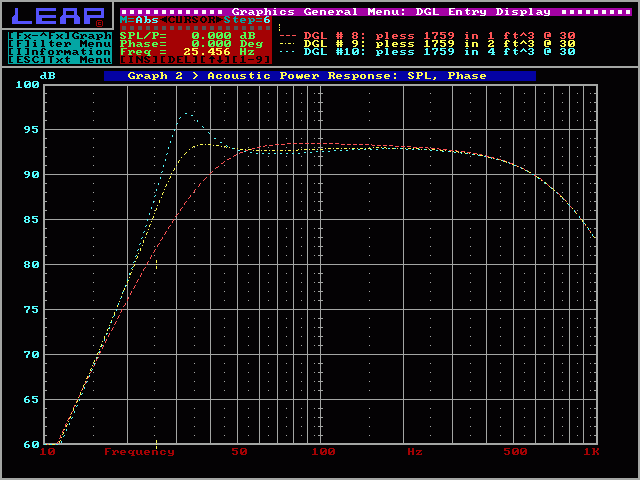
| Red curve |
Yellow curve |
Cyan curve |
Enclosure volume =
1ft^3 |
Enclosure volume =
2ft^3 |
Enclosure volume =
4ft^3 |
Port tuning frequency =
30hz |
Port tuning frequency =
30hz |
Port tuning frequency =
30hz |
On this graph, you can see how tuning a 2 cubic foot enclosure to 3 different frequencies results in 3 different frequency response curves. The violet curve has the highest peak (@ 50hz) in output but rolls off earlier than the other curves. You can see that the output of the violet curve is approximately 6dB less than the red curve at 30 hertz.

| Red curve |
Green curve |
Violet curve |
Enclosure volume =
2ft^3 |
Enclosure volume =
2ft^3 |
Enclosure volume =
2ft^3 |
Port tuning frequency =
30hz |
Port tuning frequency =
35hz |
Port tuning frequency =
40hz |
As was stated earlier, if the tuning frequency is set too high, the woofer may be damaged due to the lack of damping below the port frequency. This graph shows how the excursion increases below the port frequency. At 30 hertz, the excursion of the speaker in the enclosure tuned to 40hz is going to move 3 times as far as the speaker in the enclosure tuned to 30hz. If driven at high power levels, the speaker in the enclosure tuned to 40hz would likely start to bottom out and possibly be damaged.
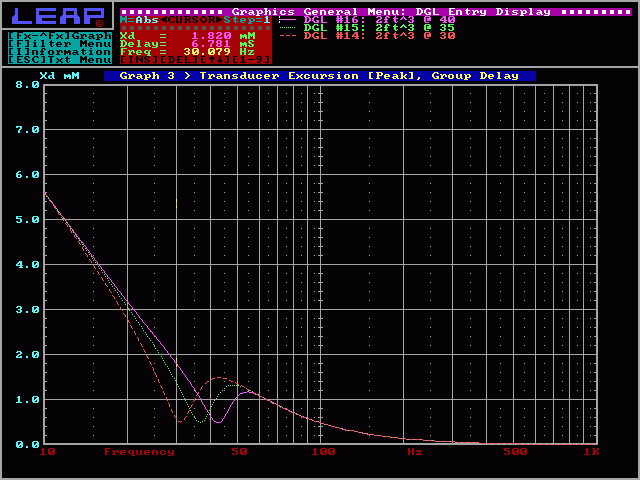
| Red curve |
Green curve |
Violet curve |
Enclosure volume =
2ft^3 |
Enclosure volume =
2ft^3 |
Enclosure volume =
2ft^3 |
Port tuning frequency =
30hz |
Port tuning frequency =
35hz |
Port tuning frequency =
40hz |
Sealed Rear Chamber Bandpass Enclosures
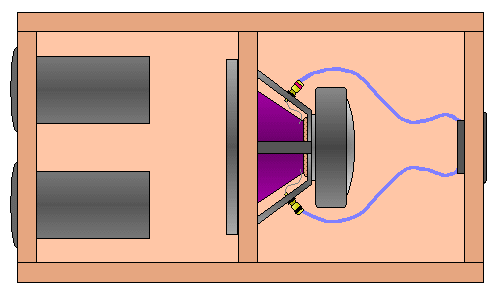
Bandpass enclosure are the most difficult enclosures of all of the designs that we have discussed so far. They must be designed specifically for a particular woofer. The generic prefab enclosures that are available in stores are a gamble. There is no way to tell how they will perform with your woofers. Hopefully, this section will help to further your understanding of bandpass enclosures and how they perform in different configurations.
This image shows the predicted frequency response for a single woofer with 3 different frequency curves. The difference in the curves is due to different front chamber volumes in the 3 different enclosures. The highest peak gives 6dB of gain over the nominal efficiency of the woofer. You can see that it is centered at approximately 50hz. The middle (green) curve shows an enclosure that gives no gain but has a flatter response over a wider area. This enclosure would be easier to blend into the rest of the audio band (being produced by the midbass, mid and high frequency drivers) than the enclosure used to produce the red curve. The violet curve is also very flat and may be a good choice if efficiency is not really important to you.

| Violet curve |
Green curve |
Red curve |
| Rear volume = 2.68ft^3 |
Rear volume = 2.68ft^3 |
Rear volume = 2.68ft^3 |
| Front volume = 1.05ft^3 |
Front volume = 2.10ft^3 |
Front volume = 4.20ft^3 |
Port tuning frequency =
52.5hz |
Port tuning frequency =
52.5hz |
Port tuning frequency =
52.5hz |
This image shows an enclosure designed for the same 3 frequency response curves as in the previous graph but is designed for (and uses) a different woofer. You can see that the curves are the same but the peak is centered at about 70hz.
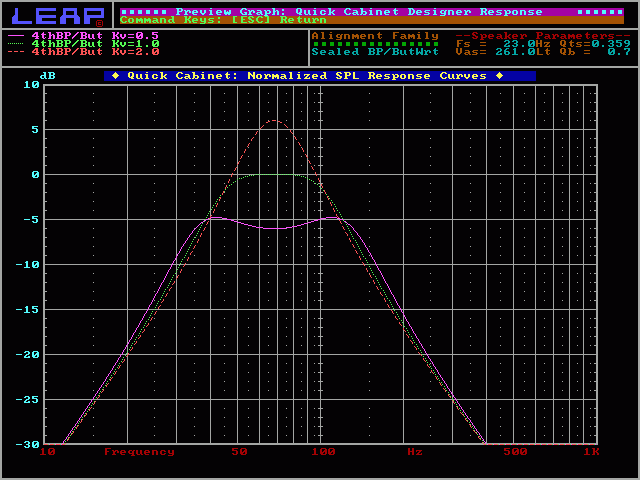
| Violet curve |
Green curve |
Red curve |
| Front volume = 1.17ft^3 |
Front volume = 1.17ft^3 |
Front volume = 1.17ft^3 |
| Rear volume = 0.52ft^3 |
Rear volume = 1.04ft^3 |
Rear volume = 2.08ft^3 |
Port tuning frequency =
68hz |
Port tuning frequency =
68hz |
Port tuning frequency =
68hz |
If you looked at the sizes of the enclosures in both of the previous examples, you will notice that the woofers use different size enclosures to produce the 3 curves. You should have also noticed that the curves for the 2 different woofers are centered at different frequencies.
In the image below, the 3 different curves show the frequency response of 3 different woofers in the same bandpass enclosure. It shows that the enclosure is not perfect for any of the 3 woofers. The woofer producing the response shown by the cyan colored line is best matched (but not perfectly matched) to the enclosure. This is why I said that you don't really know what kind of results you will get when you buy a prefab bandpass enclosure. All woofers will work differently in a given enclosure.

One Woofer Many Curves:
The image below shows the frequency response for a given speaker in 5 different enclosures.

| Violet curve |
Green curve |
Red curve |
Yellow curve |
Cyan curve |
Enclosure =
Sealed |
Enclosure =
Ported |
Enclosure =
Bandpass #1 |
Enclosure =
Bandpass #2 |
Enclosure =
Bandpass #3 |
Total volume =
2.68ft^3 |
Total volume =
4.16ft^3 |
Total volume =
3.73ft^3 |
Total volume =
4.78ft^3 |
Total volume =
6.88ft^3 |
Transfer Function:
All vehicles have an effect on the low frequency response of your audio system. For subwoofers, it means a a 15 to 25dB gain in SPL at some frequencies. This means that in some vehicles the SPL, at the lowest of frequencies, will be as much as 25dB higher than if the speakers were in the middle of a large open area (i.e. in the middle of a football field). In the image below, The red line is the speaker/enclosure without the vehicle's transfer function. The violet line is an estimate of some hypothetical transfer function of an unnamed vehicle (just a rough guess actually :-). The yellow line is the output of the speaker with the influence of the transfer function. As you can see, the response of the system inside the vehicle is much higher at the lower frequencies.
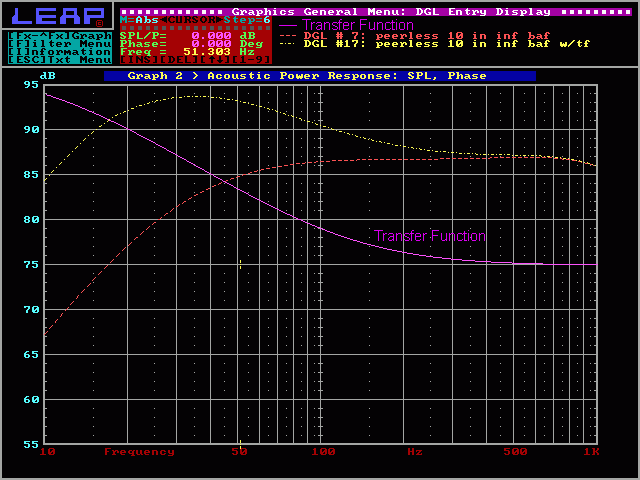
Note:
Many bandpass boxes are designed to produce a single note with a lot of gain. This means that there will be a peak in the output at that single frequency but the rest of the spectrum suffers. These boxes might sell in the stores because the salesman knows what song/music will be the most impressive with the enclosure and woofer(s). What the customer doesn't realize is that the chances of getting truly good sound quality from an enclosure with such a sharp peak in its output is nearly impossible. Using that type of enclosure produces the type of system that can only play one or two notes loudly.
Using Poly-fill:
Poly-fill can be used to make an enclosure seem slightly larger. It does this by slowing the movement of the air in the enclosure. This, in effect, smoothes the frequency response of the subwoofer's output and slightly improves its low frequency extension. This image shows, to what degree, it does both. The red line (no fill) has a slightly higher peak than the yellow line before it starts to roll off. The yellow line has a slightly improved low frequency extension when compared to the red line. The effect is not very dramatic but using poly-fill in this manner can sometimes make a subwoofer sound better. The red curve is has no poly-fill. The yellow line is 100% filled with poly-fill. 100% fill is equal to 1 pound of poly-fill per cubic foot of air space.
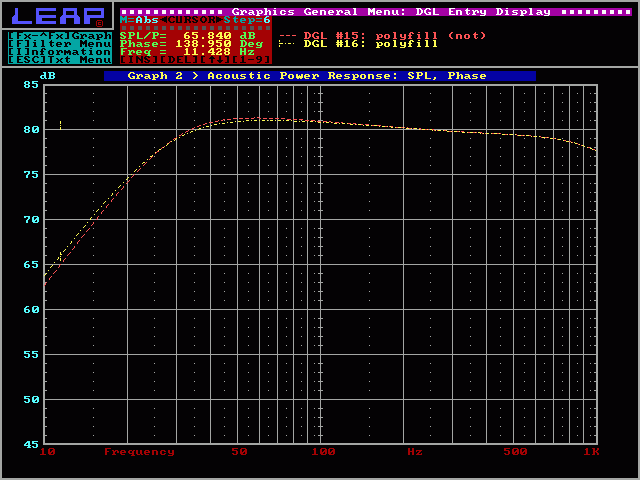
Standing Waves:
Standing waves are not usually a big problem in a subwoofer because it is usually crossed over. In other situations, like home speakers, poly-fill can be used to damp standing waves. In home speakers, the woofer is often used to reproduce a wider frequency range than it would be in a subwoofer. This creates the opportunity for standing waves to create problems. The wavelength is too long in the lowest frequencies to cause a problem but frequencies above 300 or 400hz will start to cause problems. This is especially true in ported boxes because the port creates a conduit through which the higher frequencies can pass (from the inside of the enclosure).
|




